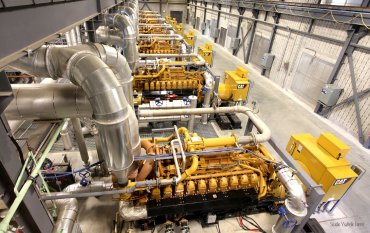
As policies encouraging lower emissions and higher-efficiency equipment influence the types of fuels used to meet rising energy demand, methane and other waste gases in municipal landfills can be harnessed to generate electricity, which could increase demand for gas piston engines and, by extension, gas engine oil additives.
These additives, however, must meet stringent operating conditions and adapt to changing equipment designs. Landfill gas engine oils have the added challenge of curbing the damaging effects of contaminants in landfill gases, several industry insiders told Lube Report.

Photo courtesy of Caterpillar
Caterpillars G3516H gas engine is used alongside generators and other conversion equipment to turn landfill gases into electricity.
Gas engine lubricants need to provide protection to valves, gears, bearings, cylinders, liners and piston rings in these reciprocating gas engines through acid neutralization and control of oxidation and nitration over longer drain intervals, regardless of fuel or base stock chosen, additive maker Infineum noted in its 2018 Infineum Insight presentation.
As a result of rising operating temperatures and pressures, as well as the presence of contaminants, both additive and oil suppliers have to continuously develop gas engine lubricants that address the harmful effects of landfill gases on equipment.
Landfill gas, also called biogas, is generated due to anaerobic decomposition, a process in which bacteria break down biodegradable material in the absence of oxygen to produce methane – the primary component of natural gas – carbon dioxide and other organic compounds. Biogas has the advantage of being a renewable source compared to its fossil fuel counterpart.
Municipal solid waste landfills are the third-largest source of human-related methane emissions in the United States, making up about 15.4 percent of these emissions in 2015, according to the U.S. Environmental Protection Agency. The agency estimated that about 575 municipal solid waste sites in the country provide landfill gas to 469 operating power generation projects.
The reciprocating [gas] engine is the most commonly used conversion technology for landfill gas electricity applications because of its relatively low cost, high efficiency and size ranges that complement the gas output of many landfills, the EPA expanded.
Biogas from landfills or digester power plants have a number of contaminants: sulfur compounds such as hydrogen sulfide, halides that include fluorides and ammonia, and organosilicon chemicals called siloxanes. All of these contaminants create deposits that generate wear and corrosive acids that can lead to oil degradation and affect the equipments durability, said Hind Abi-Akar, fluids technical expert for Caterpillars fluids engineering unit.
Often found in decomposed plastic and gel components of biomedical and cosmetic products, siloxanes generate silica deposits that can reach the combustion chamber of a gas engine, coating hot surfaces of engine parts with a thick, hard and abrasive layer, said Virginia Carrick, global stationary natural gas technology manager at Lubrizol.
She explained that high levels of silica deposits in the engine can increase oil consumption, trigger pre-ignition, generate abrasive wear and make top-end overhauls and piston ring and liner replacements more frequent.
Valves are another component requiring a formulation that can prevent both corrosion and valve recession from occurring. In landfill gas engines, the valves, and specifically the exhaust valve, is the main component attacked by the siloxane, said Andy Donlon, Americas oil and gas lubrication engineer at ExxonMobil.
He explained that valves are cushioned by the sulfated ash that forms once the engine oil additives are burned at high temperatures in the combustion process. This white sulfated ash coats out on the exhaust valve face and cushions it from recessing into the valve seat in the head, he noted.
The biggest change over the past several years is a preference from North American original equipment manufacturers for oils that contain less than 0.5 percent sulfated ash, said Shawn Ewing, technical coordinator, commercial products at Phillips 66.
Historically, higher ash fluids were used in this application to counter the effects of hydrogen sulfide, but the additional sulfated ash led to deposits on the engine valves, resulting in failures, he explained.
Phillips 66 released its El Mar LF-D gas engine lubricant in January, which has low ash content and is zinc free to minimize deposits in modern landfill applications. Similarly, Lubrizol launched its SG9L60 additive package in August, which breaks down silica particles into smaller molecules that are then suspended in the oil.
Caterpillar recommends equipment operators use gas engine oils with an additive package that has an adequate total base number to address these issues and that can prevent deposits on pistons, liners and cylinder heads, said Abi-Akar. The oils must be full synthetic or semi-synthetic, SAE 40 viscosity with minimal ash content to reduce deposit buildup on valves and turbine wheels of the turbocharger.
At the same time, they must demonstrate adequate protection in a controlled, 7,000-hour field evaluation, since there is no industry specification for these types of engines, she added.
Read the full-length article in the June 2018 issue of LubesnGreases magazine by clicking here.